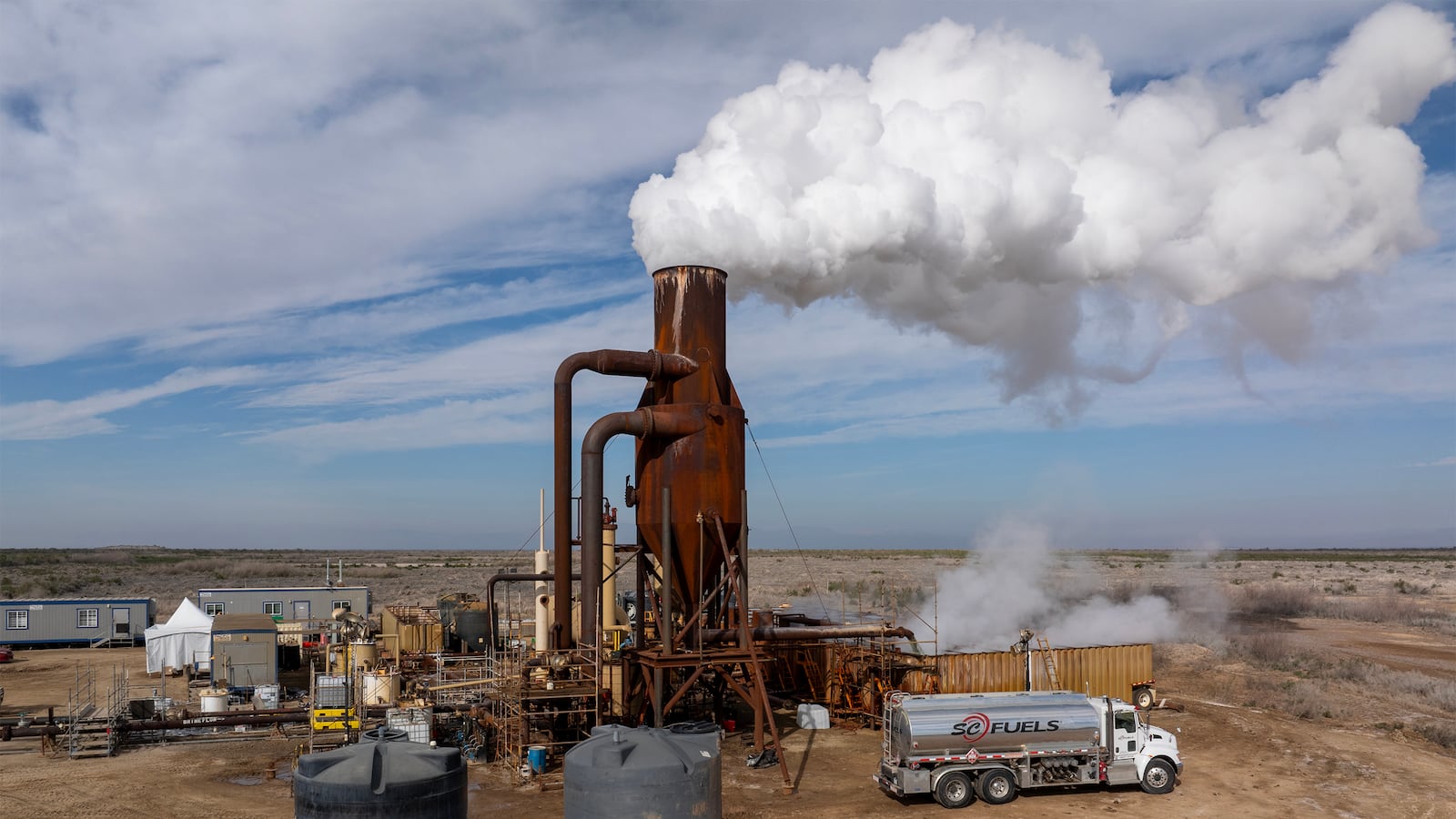In the heart of Imperial Valley, California, a project by U.S. firm Controlled Thermal Resources (CTR) is setting the stage for a major shift in the availability of lithium in the U.S.—and possibly around the world.
The project takes place in the Salton Sea, a shrinking lake north of the California-Mexico border home to a lithium reserve capable of fulfilling the entirety of the U.S.’s and 40 percent of the world's projected lithium demand. The reserve has the potential to produce “over 600,000 tons” of lithium resources a year, Rod Colwell, CEO of CTR, told CNBC.
“The U.S. is still in the beginning phase,” Erik Desormeaux, director of application development at energy efficiency firm Energy Recovery, Inc, told The Daily Beast. “Even though a lot of the innovation and battery technology started here, most of the mining, processing, and manufacturing still happens overseas. In the future they’re projecting a lot more lithium demand than supply, which is opening up more opportunities for lithium mining in the U.S..”
The $1.8-billion Hell’s Kitchen lithium-geothermal project, which will use CTR’s lithium extraction plant and absorption technology, will potentially reduce dependency on lithium imports and fuel the growth of electric vehicles. Localizing lithium extraction allows the U.S. to ensure a more secure supply of this critical raw material—reducing dependency on foreign sources. This also aligns with broader goals like achieving energy independence and meeting climate change commitments. Local lithium production can also increase competitiveness of American-made EVs and related technologies on the global market.

Steam rises from fumaroles, or steam vents, situated between two of the five Salton Buttes lava dome volcanoes that line the southeastern edge of the Salton Sea and are heated by magma under the Salton Sea Geothermal Field.
David McNew/Getty ImagesThe project also hopes to rejuvenate the Salton Sea area, a region that’s been in decline in recent decades due to high unemployment and environmental degradation. The Hell’s Kitchen project plans to leverage the abundant geothermal steam of the Salton Sea to extract and concentrate lithium in an environmentally friendly manner—a massive technological and sustainable leap for the U.S. lithium market.
There is currently only one operational lithium mine in the nation: Thacker Pass, which is located in Nevada. The mine was approved in 2021 after two years of legal dispute with environmentalists and Native American tribes fighting for a few species who inhabited this land as their priority habitat. The Salton Sea geothermal plant may offer the opportunity to extract lithium in a less destructive way.
The Briney Deep
Lithium comes primarily from two geological sources: lithium-enriched brines, which are underground pools of liquid that contain high concentrations of the mineral and are most abundant in the salt lakes of South America (known as the lithium triangle); and from hard rocks, which require mining to extract. By pumping the liquid into shallow evaporation ponds, rapid evaporation leaves lithium salts behind—ready to be removed and refined for batteries.
There are many brines in the U.S. that have lithium. However, “it’s difficult to permit them [as evaporation ponds] because they take up a lot of space,” Desormeaux said. “And there are other environmental issues that make it difficult to do that in the EU, the U.S., and sometimes in South America.”
The most pressing environmental concern that comes along with evaporation ponds is water depletion, as more than 90 percent of original water content is lost to evaporation. This puts freshwater reserves at great risk, which threatens local ecosystems and communities.

Emir Salas, lead chemist at Controlled Thermal Sources, shows off brine with metals extracted at their Hell’s Kitchen test facility near the Salton Sea in Niland, California.
MediaNews Group/Orange County Re/Jeff Gritchen/MediaNews Group/Orange County Register via Getty ImagesThat’s why many start-ups are using direct lithium extraction (DLE), a process which shifts from traditional, environmentally-taxing lithium extraction methods to cleaner processes. It does this through a process called absorption, which is essentially like using a sponge designed to soak up lithium from a brine, rather than all of the other salts naturally found in it—reducing the necessary amount of water and land.
The Hell’s Kitchen project will use geothermal brine, which leverages geothermal power plants to extract underground brine and converts it into steam. The project will also use ceramic beads to absorb the lithium from the Salton Sea. CTR then plans to refine it on-site into a powder that will be ready to process and manufacture into batteries—two processes that will be outsourced and predominantly take place in Asia.
A Wildlife Morgue
The Salton Sea has been rife with environmental challenges in the past decades, as the rapidly evaporating lake has led to toxic dust blow-off, causing health issues among the largely Mexican-American population that lives in the surrounding area. The now arid and shrunken lake has also become a wildlife morgue, with agricultural runoff, horrible air quality, and toxic metals in the soil causing widespread deaths of fish and waterbirds.
Locals and environmentalists are advocating for a portion of the money earned from the extraction plant to go back into lake restoration and the local community. “In general, I think the people who know how DLE works aren’t as concerned with the direct environmental impact as they are with the indirect, like, ‘Is the energy coming from renewable sources?’” Desormeaux said. “In the Salton Sea, it’s coming from geothermal, which is considered renewable.”
So despite the promise, the project is met with hesitance from both industry experts and environmentalists as DLE from geothermal brines at such a scale is unprecedented. “Extracting lithium from geothermal brines has never been done before at scale, so it remains to be seen whether the electric-vehicle industry, the local community and/or the environment will actually benefit,” Desormeaux said.
And the economics of the new extraction plant are yet to be proven lucrative. Time will tell whether this nascent technology can successfully extract lithium from brine cost-effectively at a commercial scale.
The Hell’s Kitchen project is expected to deliver significant amounts of lithium hydroxide within the year, contributing to the EV industry and chip production. The commitments from major corporations like General Motors to source lithium from CTR highlight the project’s significance and opportunity.
“I think people are very optimistic about the project but it’s a lot of ‘Wait and see,’” Desormeaux said. “I think people think the problems are all solvable but until they figure them out there will still be a lot of skeptics.”







